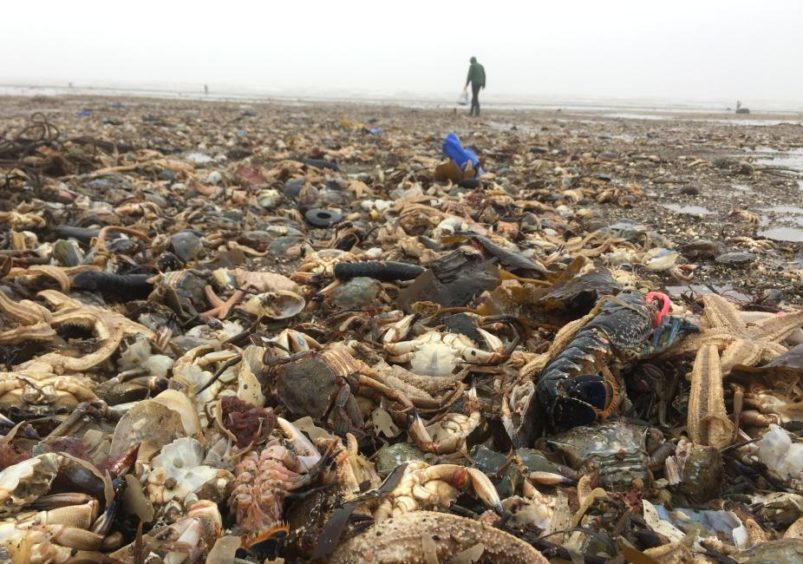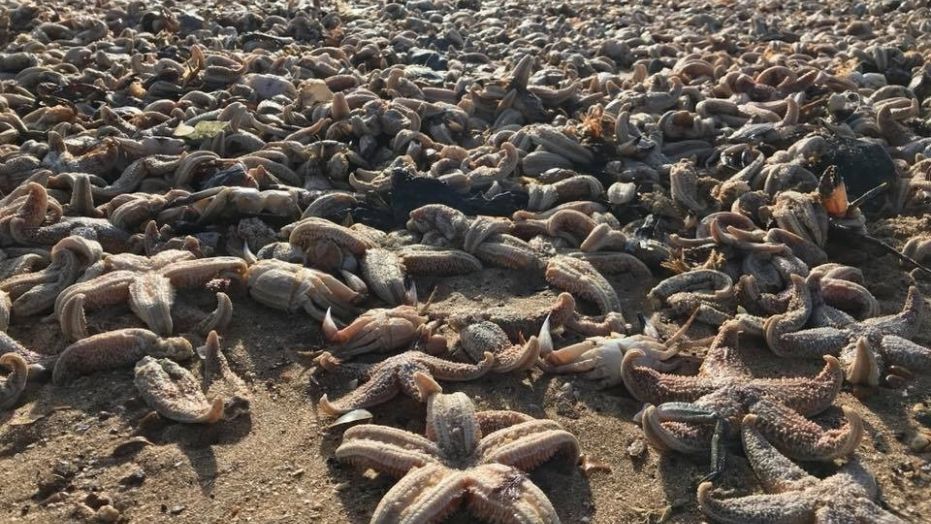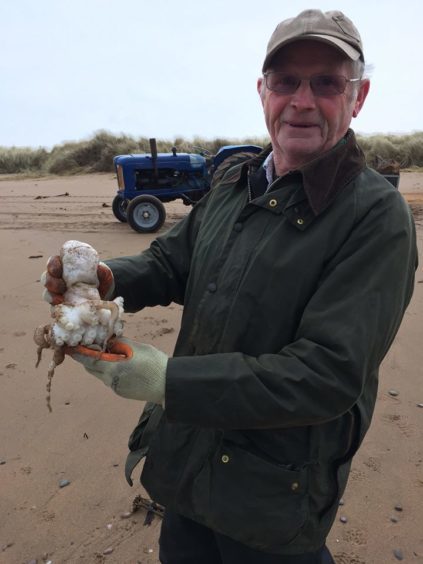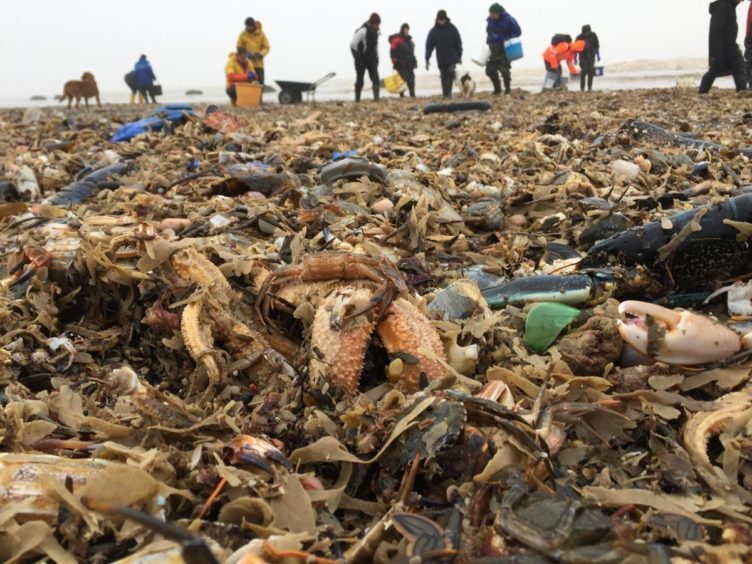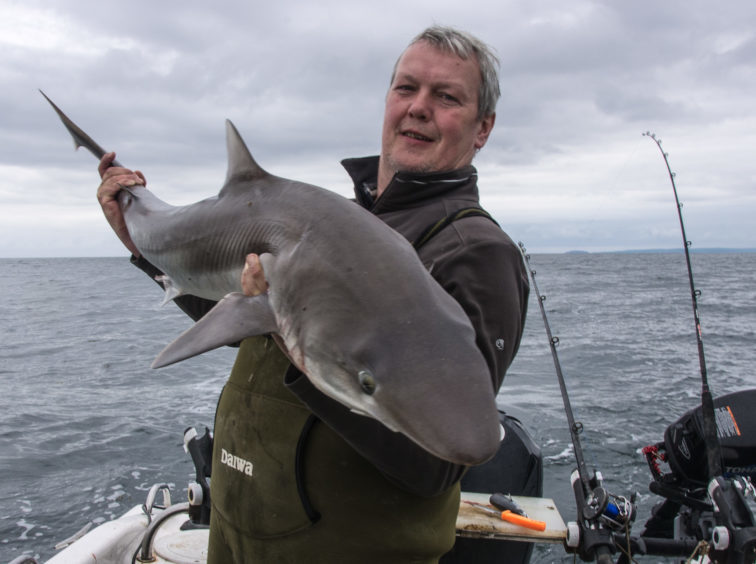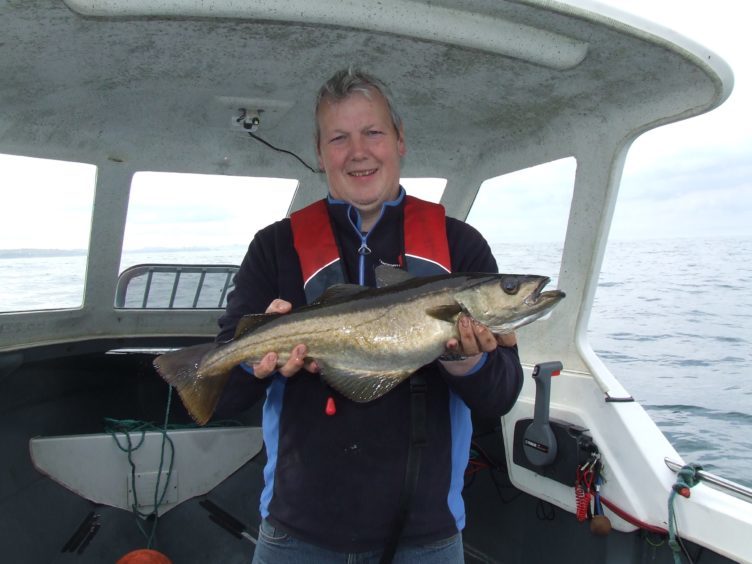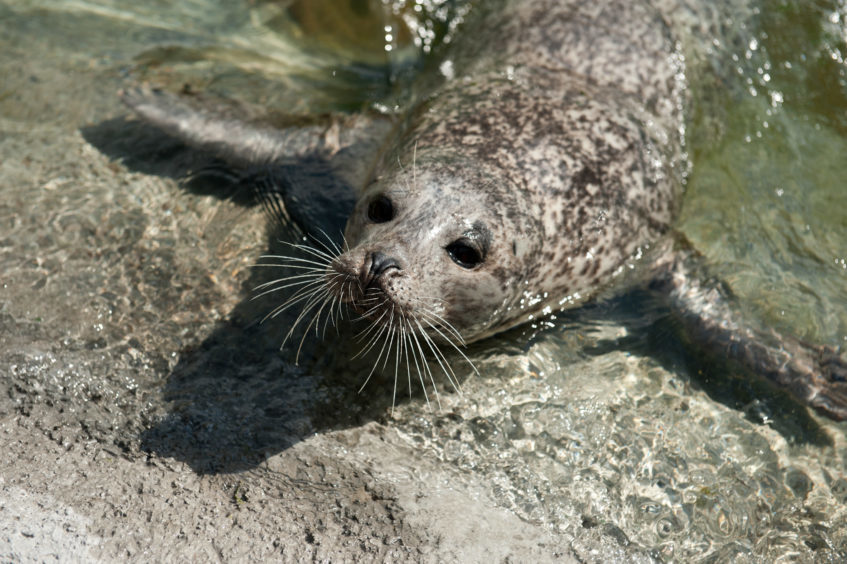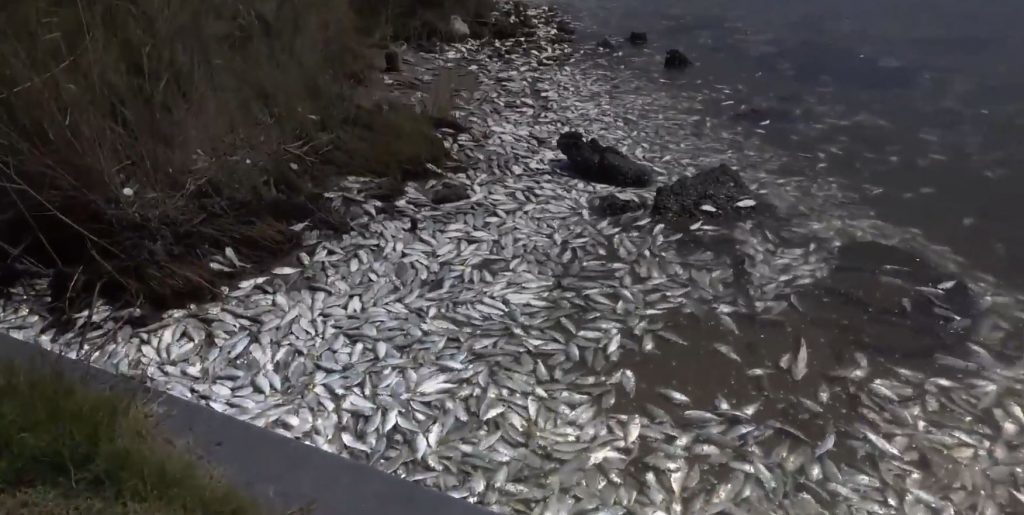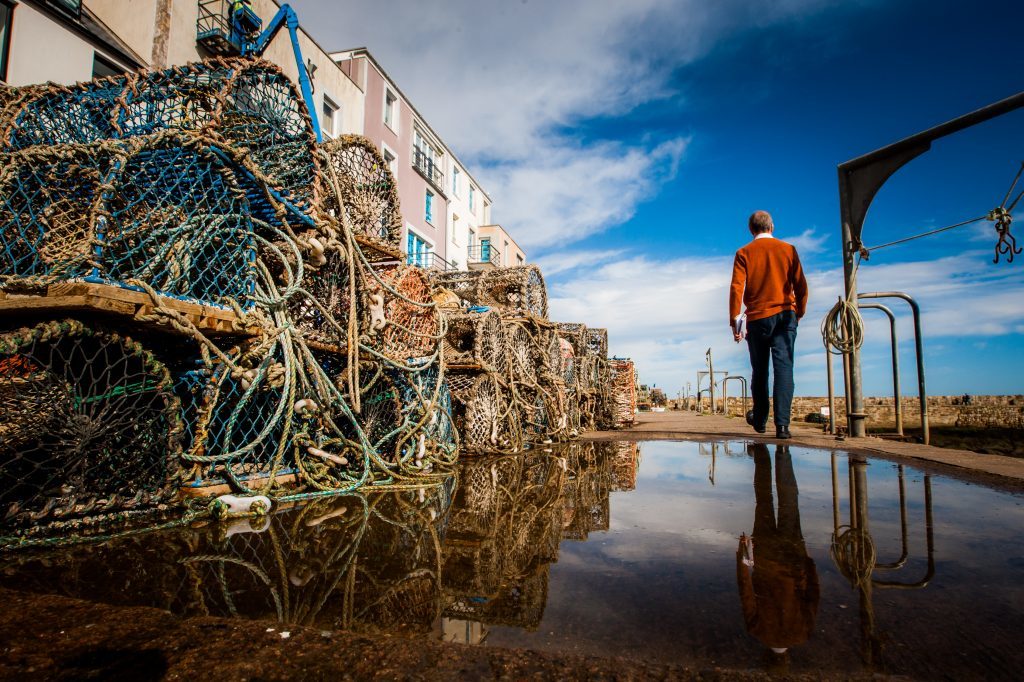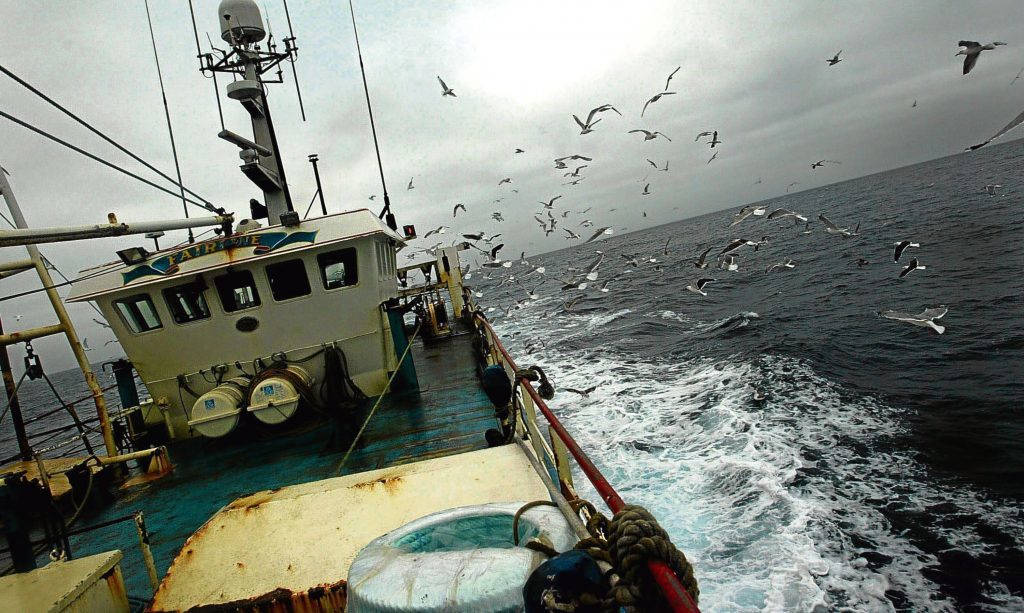As ‘post-apocalyptic’ images show thousands of dead sea creatures washed up on UK beaches, Michael Alexander looks at the reasons.
Strewn helplessly across the seaweed covered beach amid the roar of storm-fuelled spray, the 25 dead octopus littering a 300 metre stretch of beach at East Haven in Angus looked pitiful as the retreating waves abandoned them at the high water mark.
A few days later, walkers on the West Sands a few miles down the coast in St Andrews reported dozens of dead cuttlefish, lobsters and crabs.
They were joined by the carcass of a forlorn looking giant conger eel – while this week a female dog walker compared the beach to the “aftermath of a mini tsunami” after discovering it was littered with thousands of razor clams.
These apparently apocalyptic scenes have not been unique to Courier Country.
Further down the North Sea coast in Yorkshire, there were reports of tens of thousands of starfish, crab, mussels and lobsters – piled “ankle-deep” in places – being washed up along the Holderness coast with similar mass mortality reported in Kent and Norfolk.
Coinciding with the so-called Beast from the East, beach walkers took to social media in their droves to share sad images of deceased sea creatures and to conclude that they had simply succumbed to the particularly fierce conditions as wind and snow drove in relentlessly from Siberia.
But with weather forecasters predicting a return to cold easterly winds this weekend, can we expect similar carnage?
And with predictions about the on-going impact of climate change, can we expect tougher conditions for sea life and even changes to the type of life that exists in our seas full stop?
According to marine biologists, mass starfish strandings aren’t completely unheard of.
For example, several million were found on the coast of Worcester County, Maryland, USA in 1960.
Up to 10,000 were found along the strandline on the Isle of Man in 1999.
And 50,000 were stranded on the Irish coastline in 2009.
The exact reasons for mass strandings are not known.
But they are often blamed on very cold weather or storms.
The Beast from the East was a polar vortex that brought freezing temperatures and high onshore wind gusts onto the eastern coastline of the UK.
High winds can disturb the seas along the coast, creating large waves that churn up the seabed where many animals reside.
Sediments on the seabed are disturbed and can smother these animals.
Animals picked up by these disturbances can be moved high up the shore during the high tides and are left stranded as the tide retreats.
Coincidentally, during the peak of the storm, UK shores also experienced low spring tides, which likely made the marine effects of these high winds worse.
Methil-raised angler and boat owner Ian Lindsay, 55, who has been fishing from the age of nine, regularly fishes out of St Andrews Harbour and catches mainly cod, Pollock, whiting, mackerel and herring.
The Newport-based St Andrews University psychology graduate, who studied marine biology as part of his second year zoology course, says there have been some “occasionally unusual” Mediterranean catches in St Andrews Bay in recent years.
He once saw the fin of a Sunfish and knows of a local pot fisherman who caught a subtropical Red Mullet.
He also recalls dozens of another Mediterranean species Ray’s Bream being washed up in Methil.
But generally speaking he does not think there’s anything unusual about the recent scenes of carnage on Fife and Tayside beaches.
“I think to be honest these things (like cuttlefish, octopus and conger eels) are there all the time,” he said.
“We are not normally aware of them because we do not come into contact with them.
“When there’s an extreme storm it brings them ashore.
“I think what happens occasionally is that with the Gulf Stream up the west coast, some Mediterranean species make it this far. But it’s not that common to see them.”
Stormy seas on the Fife coast are nothing new – and as regular visitors know, it’s not unusual to see storm bound sea birds or dead creatures washed up on the shore.
But sometimes an incident happens which captures the public’s imagination – such as the North Sea storm which battered the Fife coast on March 30 2010, and had devastating consequences for one of the St Andrews Aquarium tourist attraction’s most popular residents.
An 18-year-old male seal called Hardy was washed out of his pool by a huge storm surge.
His female partner Laurel, who died in 2015, was also in the same pool but managed to avoid the wave.
The public were urged to look out for Hardy who had never lived in the wild and did not know how to feed himself. But sadly, he was never seen again.
Esther Brooker, Marine and Policy Officer at WWF Scotland said climate change is definitely having an impact on the bigger picture when it comes to marine life.
She said of recent events: “Although it’s impossible to say with certainty what caused the death of these creatures it’s likely that the drop in North Sea temperature and the strong winds played an important part.
“Climate change is impacting on our wildlife today and we know from a recent WWF report that up to half of plant and animal species in in our most rich wildlife areas, such as the Amazon and Galapagos, could face local extinction if carbon emissions go unchecked.
“By taking bold action to tackle climate change and supporting progressive marine conservation measures, we can help mitigate the worst impacts.
“ This year we could see world leading climate legislation passed by the Scottish Parliament and the significant progress in designating Scotland’s network of Marine Protected Areas.
“ Both must fulfil their potential if we’re to play our full part in protecting our precious environment for today and future generations.”
